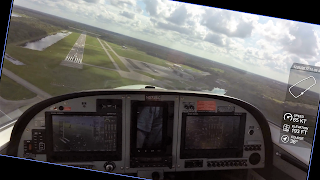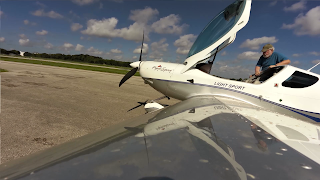 I always check the winds before going out to the airport. My personal limit is 18kts for students or pleasure flying. I may make an exception for a cross country flight if I'm flying into improving weather, but 24kts is always a firm "No Go". So when the reported winds were light and variable I was anxious to go out for some landing practice.
I always check the winds before going out to the airport. My personal limit is 18kts for students or pleasure flying. I may make an exception for a cross country flight if I'm flying into improving weather, but 24kts is always a firm "No Go". So when the reported winds were light and variable I was anxious to go out for some landing practice.I routinely teach "power off" approaches. The throttle is pulled to idle abeam the numbers and the airplane is allowed to slow below 75kts when the full flaps are lowered. Speed continues to slow to 60-65kts while maintaining pattern altitude. That transition is usually sufficient to provide interval for the base leg. I like to stabilize the approach trimmed hands off for 60kts by the mid point on the base leg. This is a good point to evaluate the glideslope and make a power adjustment if low. I want to be fully stabilized following the base to final turn. Raising the nose to slow to 55kts over the fence followed by minor power adjustment to control the rate of descent is done until the field is made, then power off into the round out and flare. Usually two turns in the pattern is enough for me to calibrate my pattern to adjust for winds such that I can keep the power at idle for the entire approach. Not today.
 "Light and variable", is not to be confused with "no wind". I listened to the AWOS then to other pilots already in the pattern and the preferred runway this morning was RWY5. The windsock hung limp on its post on the other side of the runway. Two C172s landed as I did the runup, each landed a bit long which is normal in light wind situations. All systems were good so I took the runway once the last plane cleared at the end. Temperature was in the mid 80°F but the climb out was very good. I reached pattern altitude before turning downwind. The wind vector arrow on the SkyView showed a 5kt westerly crosswind and I adjusted my heading to fly parallel to the runway on the downwind leg. I hit my point "abeam" just right, made the transition but turned in a bit early. At the mid point on base I was high and when I stabilized on final I was high and fast. So I raised the nose to get my airspeed and found my touch down point would take me far beyond the numbers. I could settle for that, or I could go around. But I had a third option: Slip.
"Light and variable", is not to be confused with "no wind". I listened to the AWOS then to other pilots already in the pattern and the preferred runway this morning was RWY5. The windsock hung limp on its post on the other side of the runway. Two C172s landed as I did the runup, each landed a bit long which is normal in light wind situations. All systems were good so I took the runway once the last plane cleared at the end. Temperature was in the mid 80°F but the climb out was very good. I reached pattern altitude before turning downwind. The wind vector arrow on the SkyView showed a 5kt westerly crosswind and I adjusted my heading to fly parallel to the runway on the downwind leg. I hit my point "abeam" just right, made the transition but turned in a bit early. At the mid point on base I was high and when I stabilized on final I was high and fast. So I raised the nose to get my airspeed and found my touch down point would take me far beyond the numbers. I could settle for that, or I could go around. But I had a third option: Slip.A slip is an aerodynamic state where an aircraft is moving somewhat sideways as well as forward relative to the oncoming airflow or relative wind. In other words, for a conventional aircraft, the nose will be pointing in the opposite direction to the bank of the wing(s). Reference: Mastering the forward SlipI default to full right rudder, but in practice you should bank into the wind and use full opposite rudder. Today, with light winds, it didn't make mush difference. (However I did land right of centerline.) Some cautions must be noted:
- A slip is not a skid. A skid is an uncoordinated turn in the direction of bank. Here's a common scenario: You're turning left base to final, but you're going to overshoot the runway. What do you do? Here's what you absolutely shouldn't do: You add left rudder to tighten the turn, but you don't keep the bank and rudder coordinated - putting the airplane into a skid. As the inside wing exceeds the critical angle of attack, it stalls and drops. The deflected aileron on the low wing is still generating drag, which pulls the aircraft's nose further into the turn. And, the aircraft is still yawing into the turn from the rudder, which accelerates the roll. The result is a quick roll into the turn, and your entry into an incipient spin. That is why CFI's get nervous during the base-to-final turn.
- Speed is key. You changed the speed "vector" (from normal glide path) to increase vertical speed. When you take the slip out be very cautious that vertical speed doesn't translate into excess approach speed.
- Always be ready to go around. Neutralized the controls BEFORE applying power.
 In this case I landed a little long and had to take the second taxiway. Time to try another. But I was disappointed once again. Too high, too fast. This time I executed a "go around" (wave off). The wind vector on the SkyView showed "LT". I extended my transition deeper but when I turned final I was still too high. My speed was right on so I continued with the approach and allowed myself to land long. What the heck was going on?!?
In this case I landed a little long and had to take the second taxiway. Time to try another. But I was disappointed once again. Too high, too fast. This time I executed a "go around" (wave off). The wind vector on the SkyView showed "LT". I extended my transition deeper but when I turned final I was still too high. My speed was right on so I continued with the approach and allowed myself to land long. What the heck was going on?!?
I checked the sock. I had been landing with a tailwind. Not much, but with a Light Sport Airplane it doesn't take much. I switched to RWY 23.
The next two circuits made more sense. With the light winds I still landed a bit long but both were acceptable. I can always use more practice and felt this session was very valuable. Always respect the winds, even the little ones.
Video Notes: Comparison





